Ruben Grandia
Attention-Based Map Encoding for Learning Generalized Legged Locomotion
Jun 11, 2025Abstract:Dynamic locomotion of legged robots is a critical yet challenging topic in expanding the operational range of mobile robots. It requires precise planning when possible footholds are sparse, robustness against uncertainties and disturbances, and generalizability across diverse terrains. While traditional model-based controllers excel at planning on complex terrains, they struggle with real-world uncertainties. Learning-based controllers offer robustness to such uncertainties but often lack precision on terrains with sparse steppable areas. Hybrid methods achieve enhanced robustness on sparse terrains by combining both methods but are computationally demanding and constrained by the inherent limitations of model-based planners. To achieve generalized legged locomotion on diverse terrains while preserving the robustness of learning-based controllers, this paper proposes to learn an attention-based map encoding conditioned on robot proprioception, which is trained as part of the end-to-end controller using reinforcement learning. We show that the network learns to focus on steppable areas for future footholds when the robot dynamically navigates diverse and challenging terrains. We synthesize behaviors that exhibit robustness against uncertainties while enabling precise and agile traversal of sparse terrains. Additionally, our method offers a way to interpret the topographical perception of a neural network. We have trained two controllers for a 12-DoF quadrupedal robot and a 23-DoF humanoid robot respectively and tested the resulting controllers in the real world under various challenging indoor and outdoor scenarios, including ones unseen during training.
AMOR: Adaptive Character Control through Multi-Objective Reinforcement Learning
May 29, 2025Abstract:Reinforcement learning (RL) has significantly advanced the control of physics-based and robotic characters that track kinematic reference motion. However, methods typically rely on a weighted sum of conflicting reward functions, requiring extensive tuning to achieve a desired behavior. Due to the computational cost of RL, this iterative process is a tedious, time-intensive task. Furthermore, for robotics applications, the weights need to be chosen such that the policy performs well in the real world, despite inevitable sim-to-real gaps. To address these challenges, we propose a multi-objective reinforcement learning framework that trains a single policy conditioned on a set of weights, spanning the Pareto front of reward trade-offs. Within this framework, weights can be selected and tuned after training, significantly speeding up iteration time. We demonstrate how this improved workflow can be used to perform highly dynamic motions with a robot character. Moreover, we explore how weight-conditioned policies can be leveraged in hierarchical settings, using a high-level policy to dynamically select weights according to the current task. We show that the multi-objective policy encodes a diverse spectrum of behaviors, facilitating efficient adaptation to novel tasks.
On Solving the Dynamics of Constrained Rigid Multi-Body Systems with Kinematic Loops
Apr 28, 2025Abstract:This technical report provides an in-depth evaluation of both established and state-of-the-art methods for simulating constrained rigid multi-body systems with hard-contact dynamics, using formulations of Nonlinear Complementarity Problems (NCPs). We are particularly interest in examining the simulation of highly coupled mechanical systems with multitudes of closed-loop bilateral kinematic joint constraints in the presence of additional unilateral constraints such as joint limits and frictional contacts with restitutive impacts. This work thus presents an up-to-date literature survey of the relevant fields, as well as an in-depth description of the approaches used for the formulation and solving of the numerical time-integration problem in a maximal coordinate setting. More specifically, our focus lies on a version of the overall problem that decomposes it into the forward dynamics problem followed by a time-integration using the states of the bodies and the constraint reactions rendered by the former. We then proceed to elaborate on the formulations used to model frictional contact dynamics and define a set of solvers that are representative of those currently employed in the majority of the established physics engines. A key aspect of this work is the definition of a benchmarking framework that we propose as a means to both qualitatively and quantitatively evaluate the performance envelopes of the set of solvers on a diverse set of challenging simulation scenarios. We thus present an extensive set of experiments that aim at highlighting the absolute and relative performance of all solvers on particular problems of interest as well as aggravatingly over the complete set defined in the suite.
Autonomous Human-Robot Interaction via Operator Imitation
Apr 03, 2025Abstract:Teleoperated robotic characters can perform expressive interactions with humans, relying on the operators' experience and social intuition. In this work, we propose to create autonomous interactive robots, by training a model to imitate operator data. Our model is trained on a dataset of human-robot interactions, where an expert operator is asked to vary the interactions and mood of the robot, while the operator commands as well as the pose of the human and robot are recorded. Our approach learns to predict continuous operator commands through a diffusion process and discrete commands through a classifier, all unified within a single transformer architecture. We evaluate the resulting model in simulation and with a user study on the real system. We show that our method enables simple autonomous human-robot interactions that are comparable to the expert-operator baseline, and that users can recognize the different robot moods as generated by our model. Finally, we demonstrate a zero-shot transfer of our model onto a different robotic platform with the same operator interface.
Design and Control of a Bipedal Robotic Character
Jan 09, 2025



Abstract:Legged robots have achieved impressive feats in dynamic locomotion in challenging unstructured terrain. However, in entertainment applications, the design and control of these robots face additional challenges in appealing to human audiences. This work aims to unify expressive, artist-directed motions and robust dynamic mobility for legged robots. To this end, we introduce a new bipedal robot, designed with a focus on character-driven mechanical features. We present a reinforcement learning-based control architecture to robustly execute artistic motions conditioned on command signals. During runtime, these command signals are generated by an animation engine which composes and blends between multiple animation sources. Finally, an intuitive operator interface enables real-time show performances with the robot. The complete system results in a believable robotic character, and paves the way for enhanced human-robot engagement in various contexts, in entertainment robotics and beyond.
Perceptive Locomotion through Nonlinear Model Predictive Control
Aug 17, 2022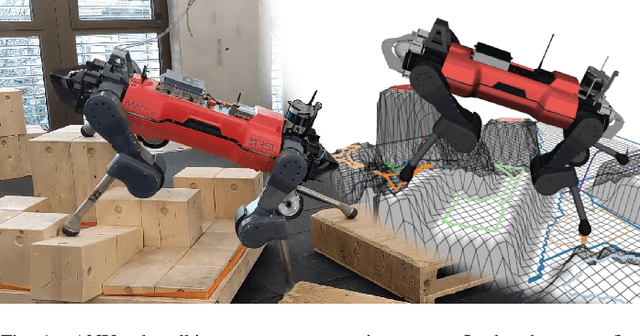
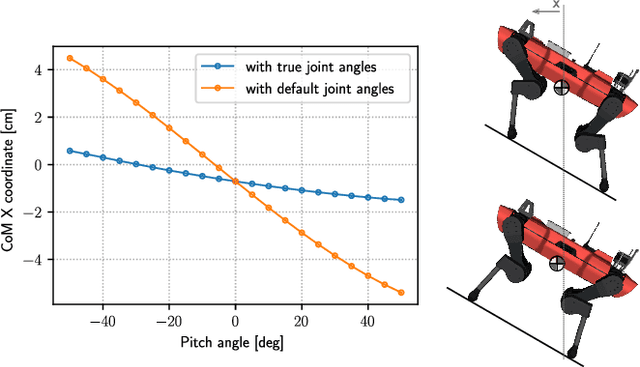

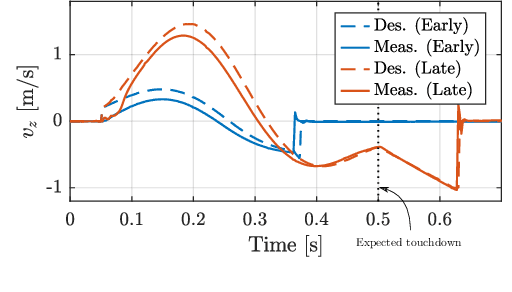
Abstract:Dynamic locomotion in rough terrain requires accurate foot placement, collision avoidance, and planning of the underactuated dynamics of the system. Reliably optimizing for such motions and interactions in the presence of imperfect and often incomplete perceptive information is challenging. We present a complete perception, planning, and control pipeline, that can optimize motions for all degrees of freedom of the robot in real-time. To mitigate the numerical challenges posed by the terrain a sequence of convex inequality constraints is extracted as local approximations of foothold feasibility and embedded into an online model predictive controller. Steppability classification, plane segmentation, and a signed distance field are precomputed per elevation map to minimize the computational effort during the optimization. A combination of multiple-shooting, real-time iteration, and a filter-based line-search are used to solve the formulated problem reliably and at high rate. We validate the proposed method in scenarios with gaps, slopes, and stepping stones in simulation and experimentally on the ANYmal quadruped platform, resulting in state-of-the-art dynamic climbing.
TAMOLS: Terrain-Aware Motion Optimization for Legged Systems
Jul 05, 2022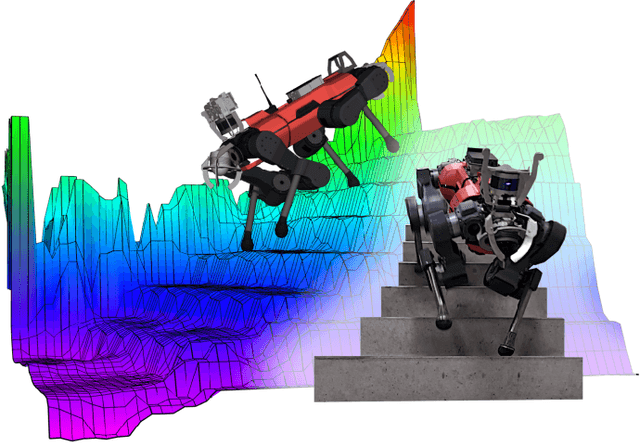
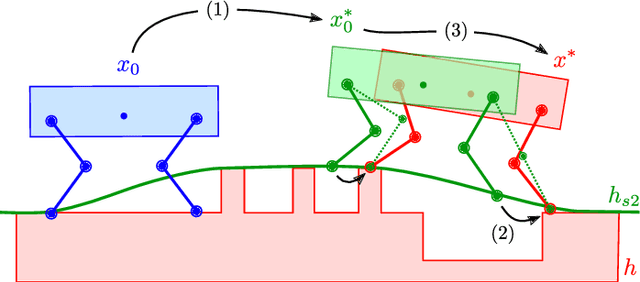

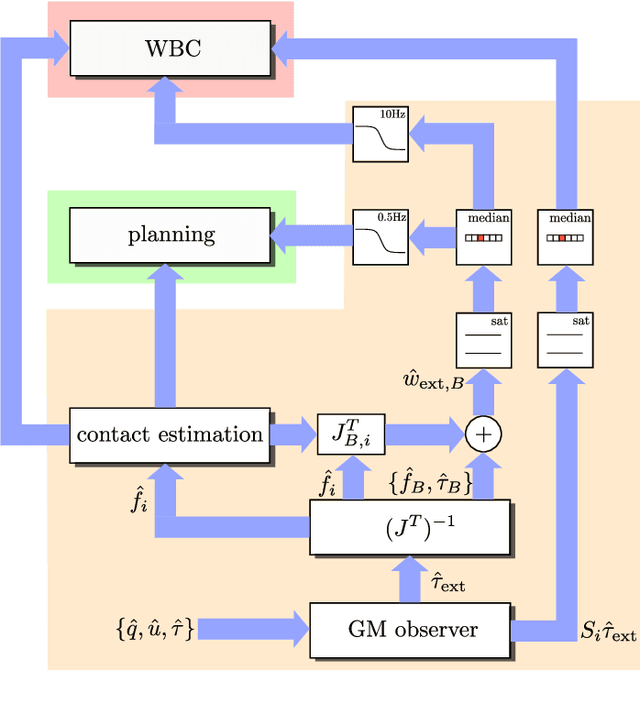
Abstract:Terrain geometry is, in general, non-smooth, non-linear, non-convex, and, if perceived through a robot-centric visual unit, appears partially occluded and noisy. This work presents the complete control pipeline capable of handling the aforementioned problems in real-time. We formulate a trajectory optimization problem that jointly optimizes over the base pose and footholds, subject to a heightmap. To avoid converging into undesirable local optima, we deploy a graduated optimization technique. We embed a compact, contact-force free stability criterion that is compatible with the non-flat ground formulation. Direct collocation is used as transcription method, resulting in a non-linear optimization problem that can be solved online in less than ten milliseconds. To increase robustness in the presence of external disturbances, we close the tracking loop with a momentum observer. Our experiments demonstrate stair climbing, walking on stepping stones, and over gaps, utilizing various dynamic gaits.
Elevation Mapping for Locomotion and Navigation using GPU
Apr 27, 2022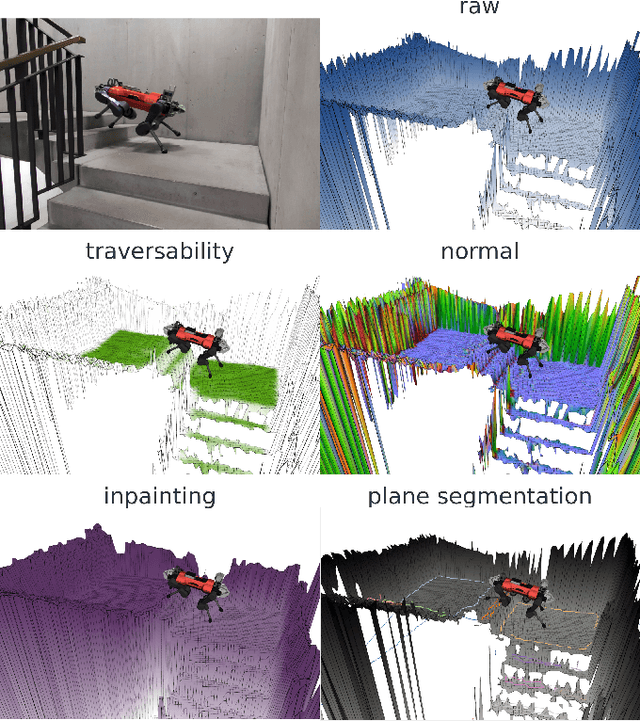
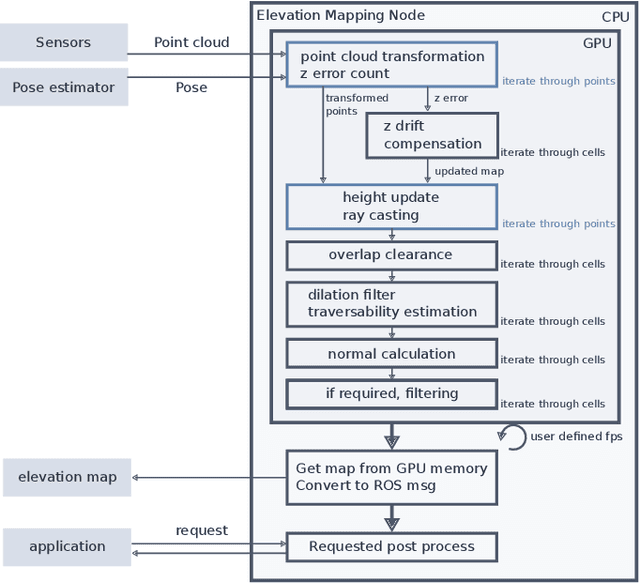
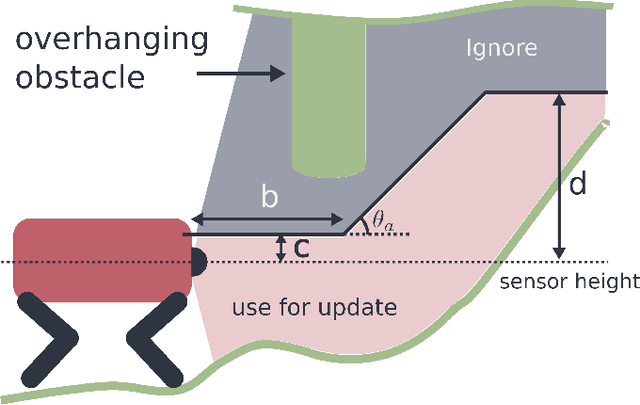
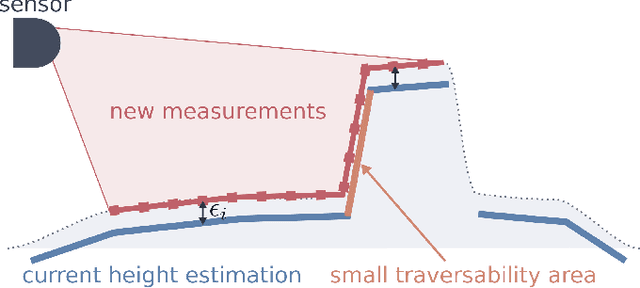
Abstract:Perceiving the surrounding environment is crucial for autonomous mobile robots. An elevation map provides a memory-efficient and simple yet powerful geometric representation for ground robots. The robots can use this information for navigation in an unknown environment or perceptive locomotion control over rough terrain. Depending on the application, various post processing steps may be incorporated, such as smoothing, inpainting or plane segmentation. In this work, we present an elevation mapping pipeline leveraging GPU for fast and efficient processing with additional features both for navigation and locomotion. We demonstrated our mapping framework through extensive hardware experiments. Our mapping software was successfully deployed for underground exploration during DARPA Subterranean Challenge and for various experiments of quadrupedal locomotion.
Bipedal Locomotion with Nonlinear Model Predictive Control: Online Gait Generation using Whole-Body Dynamics
Mar 14, 2022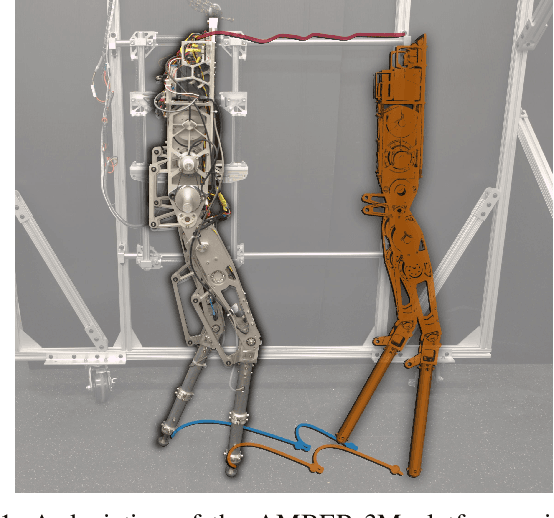



Abstract:The ability to generate dynamic walking in real-time for bipedal robots with compliance and underactuation has the potential to enable locomotion in complex and unstructured environments. Yet, the high-dimensional nature of bipedal robots has limited the use of full-order rigid body dynamics to gaits which are synthesized offline and then tracked online, e.g., via whole-body controllers. In this work we develop an online nonlinear model predictive control approach that leverages the full-order dynamics to realize diverse walking behaviors. Additionally, this approach can be coupled with gaits synthesized offline via a terminal cost that enables a shorter prediction horizon; this makes rapid online re-planning feasible and bridges the gap between online reactive control and offline gait planning. We demonstrate the proposed method on the planar robot AMBER-3M, both in simulation and on hardware.
Adaptive CLF-MPC With Application To Quadrupedal Robots
Dec 08, 2021



Abstract:Modern robotic systems are endowed with superior mobility and mechanical skills that make them suited to be employed in real-world scenarios, where interactions with heavy objects and precise manipulation capabilities are required. For instance, legged robots with high payload capacity can be used in disaster scenarios to remove dangerous material or carry injured people. It is thus essential to develop planning algorithms that can enable complex robots to perform motion and manipulation tasks accurately. In addition, online adaptation mechanisms with respect to new, unknown environments are needed. In this work, we impose that the optimal state-input trajectories generated by Model Predictive Control (MPC) satisfy the Lyapunov function criterion derived in adaptive control for robotic systems. As a result, we combine the stability guarantees provided by Control Lyapunov Functions (CLFs) and the optimality offered by MPC in a unified adaptive framework, yielding an improved performance during the robot's interaction with unknown objects. We validate the proposed approach in simulation and hardware tests on a quadrupedal robot carrying un-modeled payloads and pulling heavy boxes.
 Add to Chrome
Add to Chrome Add to Firefox
Add to Firefox Add to Edge
Add to Edge